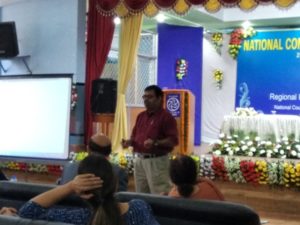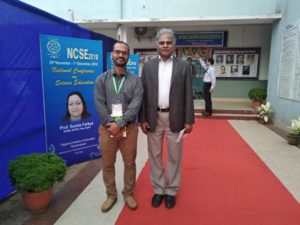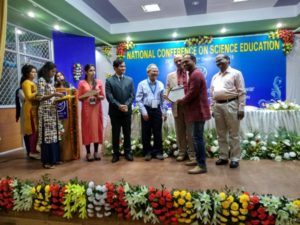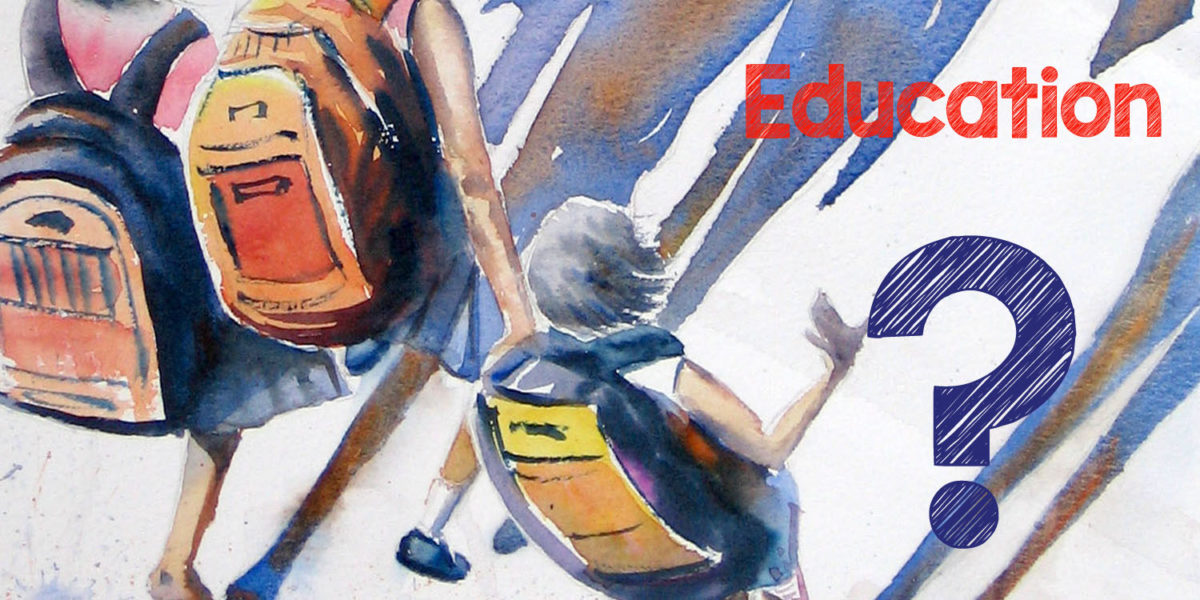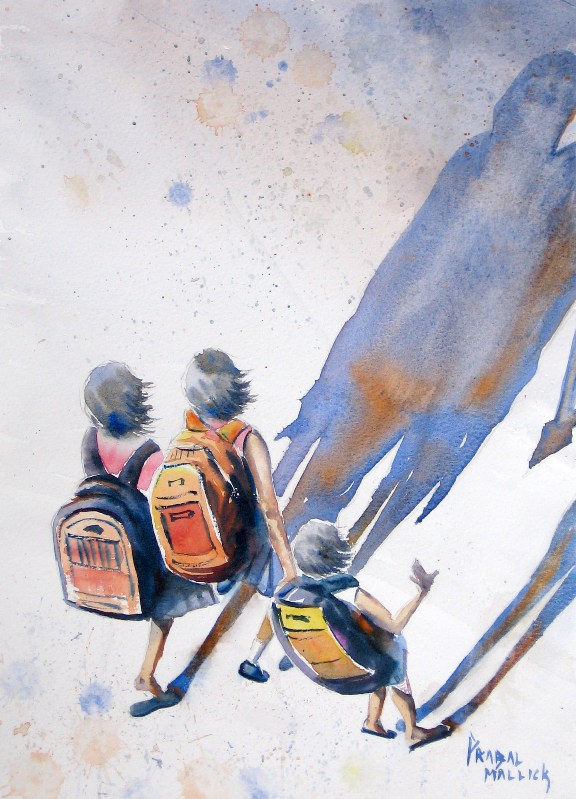This paper was presented at National Conference on Science Education at RIE, Bhubaneswar held between 29.11.2018 and 01.12.2018.
In Hindu mythology, Hiranyakasipu was an Asura king who was considered immortal because of a boon he had earned. He could not be killed by human, deva or animal, in day or in the night, indoors or outdoors, on earth or in space, with either weapon or tool. To kill Hiranyakasipu Vishnu took the form of Narasimha who was a part-human, part-animal. He came upon Hiranyakasipu at twilight, when it is neither day nor night, on the threshold of a courtyard (neither indoors nor out), and put the demon on his thighs (neither earth nor space). Using his sharp fingernails which were neither weapons nor tools, he disembowelled and killed the demon king. The lord of the universe Vishnu was forced to be creative as conventional wisdom had failed in the case of Hiranyakasipu.

When we think only in terms of conventional knowledge (what we already know) Hirayanakashipu could not have been killed. But when we think in terms of possibilities outside our knowledge then a new idea in the form of Narasimha can be born. Possibilities are things beyond our immediate knowledge. To work with possibilities is to be creative. Creativity emanates from our imagination and intuition. Imagination and intuition are two of the main pillars of education; science education notwithstanding. And these are the two things that get suppressed in our education system today.
Developing Wider Cognitive Faculties
The first thing that a child learns is language and for rest of his life all his learning is based on this faculty. As language has developed depending on our need, its usage is generally limited to what we know. Any idea that is outside the realm of language is often lost as one doesn’t have the means to express it. The correlation between language and thought has been the focus of many researchers and to a great extent it is understood that language also shapes our cognitive processes. But all human experiences cannot be expressed with language. Some are expressed better in other ways of perception like music and arts. The intelligence quotient that deals with such experiences is known as non-verbal IQ.
While language can work well enough for other disciplines it does not work well for developing a scientific mind just on its own. Learning in just the way suppresses imagination and non-verbal IQ. Hence we have to start looking at alternate ways of imparting science education. One of such ways is to make science learning experiential. When learning becomes experiential through real life and daily activities it is much more effective. However all science based learning cannot be done this way. Abstract concepts of science have to be learnt in abstract manner. But to increase understanding of the abstract according to Devi Prasad[3], other forms of perceptions need be developed in students. Sight and Sound perception are two strong perceptions which can help in learning in a great way. But these two also have not been allowed to develop in our current education system.
The faculty of sight is not as essential to our survival as the sense of touch. We live more by our touch than our sight and, we use our eyes to give information about the solidity and felt shape of things to our sense of touch. By associating touch with sight in early years of our childhood, we learn to differentiate the solid from the fluid, the soft from hard and the sharp from blunt, This association of sight and touch becomes so intimate that the habit of seeing the touch sense of things becomes habitual. Hence instead of seeing things as they are we start seeing them as we know them to be, which is informed by our sense of touch. This habit according to artist and educator Harold Speed[5] blocks our eyes and mind from having a complete visual experience of the world around us.
To illustrate this point when children are asked to draw a wooden table they end up drawing a rectangle with four legs[5]. In fact most adults too would end up drawing such an image of a table. But in reality the appearance of a table changes with the angle from where one is viewing it. But when we touch the table (even with our eyes shut) the sensation does not change. Our sense of touch informs us that there is a rectangular board with four legs. Hence most people would draw a touch representation of a table than a visual one. In this process we end up sacrificing the true capabilities of our sense of sight. The faculty of sound is also not very different and in fact it one of the least developed faculty in an average human being.

But the question is how do we develop the faculty of sight and sound in students! And the answer to this question is very simple. Just like we used the sense of touch to make sense of the world, it is through observing and understanding the world around us through our eyes and ears students can develop these senses. And this is where art education comes into picture. Though already present in the syllabus art education has been neglected and pushed down to such a level that, instead of opening up minds of students it has helped only to further close it down. Students are taught to draw symbols of things on paper instead of encouraging and teaching them the art of seeing. That is why invariable all paintings of school children end up looking same; consisting of hills, waterfalls, rivers, trees and a house. In most cases however the students drawing this picture would never have seen hills or waterfalls in their entire life.
Visual art education should help students to break out of their world of assumptions (what they know) and make them see things as they are. The job of an art teacher hence is to unblock the minds of students and increase their visual perception. Activities that can support the development of visual perception are regular sketching and painting from life and maintaining a daily visual diary (sketchbook). But the most important role is played by the teacher who helps students to open up their eyes to the visual truth around them. Similarly sound training of students can be done by learning music formally. Researchers have indicated that learning music improves brain development and increases non-musical abilities in children[1]. It can be supplemented with spending time in nature and tuning their ears to various sounds of birds, animals, rivers streams etc.
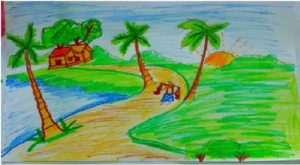
It is a known fact that Einstein credited playing his violin and visualization[4,2] capability for his scientific breakthroughs (which he called as thought experiments) and many great scientists like Copernicus, Galileo, Maxwell, and Feynman, to name a few—were all artist-polymaths. Analysing data of early scientists, we can see that the early scientists were often illustrators, poets, and musicians. This may often have been out of necessity because scientists needed to have a variety of skills that we take for granted today. A serious astronomer needed to be able to sketch his observations, and a physicist needed to recognise frequencies by their sounds while conducting an audio experiment. But the relationship between arts and other functions of brain can not be denied and hence is fast becoming an established field of neuroscience. Coined “Neuroaesthetics,” the study of how neuroscience and art intersect is a popular topic among academics.
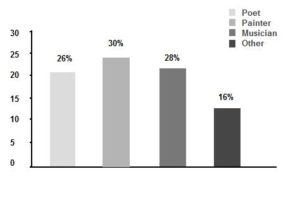
More and more studies on this topic are showing how some of the early connections are formed in the brain by regular practice of arts. In one such study[2] using eight public schools, researchers created test “art groups” with students who had fallen behind academically. The “art groups” received ongoing music and visual arts training as they progressed through the year. In just seven months, the art students that were once far behind their peers had caught up in reading and were performing 22% better in math than the other students. In a similar study, students given piano lessons over a short period of time performed over 30% better on temporal reasoning tests (Temporal reasoning is the ability to visualize three- and four-dimensional objects, a key skill for any artist or scientist).
| Tests | Performance of stronger Students without training in arts and music | Performance of weaker students after receiving arts and music training for seven months |
| Mathematics | Similar to their previous performance | 22% better than Stronger Students |
| Temporal Reasoning | Similar to their previous performance | 30% better than stronger students |
Table 1 – Correlation of art and music education to academic performance in abstract subjects in Ref[2]
Ethical Approach to Learning
The end of the Renaissance coincided with the beginning of the Scientific Revolution. Humanist education was emphasized during this period, and many scientists were trained from a young age in the arts of drawing and poetry. Later scientific development saw a surge during imperialism era as west found it to be a great tool to spread dominance over rest of the world. And in modern times science has become a slave to capitalism. It has been made to create the most destructive weapons of war and weapons that threaten the very existence of this natural world. Nature has been compromised for capitalist gains using science and technology as a medium. Science has also provided human kind all kind of unimaginable luxury and indulgence. Thus science which should have helped in eradicating inequalities has actually aggravated it[1].
The lacuna exists right in our social and education system which looks at science as a tool of gaining power. A student never learns about nature and social values in the real sense. A holistic view of the world including human conditions and our philosophical quests which can give direction to science is never allowed to develop in students. Science and its usage are glorified in our text books and are never examined critically. Alternate views are also shunned and not allowed to develop. For example green revolution is still glorified in text books as a success of science. But now it is becoming more and more clear that this unsustainable form of farming was in fact a curse for our agricultural system which not only has made the soil infertile, it has led to plethora of other problems like excess of pesticide in food, loss of indigenous varieties and bio diversity, depletion of water resources and deteriorating economic condition of farmers because of dependence on external inputs. And additionally as science shunned our traditional form of agriculture the knowledge of the same has almost been lost. It is only now that we are realizing that we have to go back to our traditional non industrial form of agriculture to solve all problems created by green revolution. In fact according a UN Conference for Trade and Development(UNCTAD) publication of 2013 – dramatically titled ‘Wake Up Before Its Too Late’, [6]small scale organic farming is the way to feed the world in future and not GMO technology. But somehow we do not tell this to our students and make them see things only in black and white.
To make proper use of scientific knowledge appropriate value system must be developed in students. This value system can not be developed by books. Arts and humanities play a big role in this but at the same time it has to be both experiential and conversation oriented. Such conversations have to be reflective in nature and not prescriptive. And the conversation can happen in the science class itself if need be and not in just humanities class. When learning happens in compartments, students get disconnected and do not look at science within the framework of a value system. Science for science sake is thus allowed to develop instead of science for society sake. To reverse the damage, it demands teachers to turn into educators and take up bigger responsibility of building character of students along with knowledge.
Conclusion
Creativity lies in fluidity of thought that is not bounded by solid compartmentalized way of perceiving the world around us. Intuition comes from wholesome understanding of the world; when we observe the world more closely using all our faculties of sense we find new ways of connecting the same dots. Our education system has been instrumental in suppressing creativity and intuitive thinking which are a must have for learning science. Moreover due to lack of focus on character building in schools science is ending up being used as a tool for satisfying the rich and powerful. In other words our education system is currently breeding Hiranyakashipus’ who are not only are mechanical and bookish in their way of thinking but also are ideologically deprived.
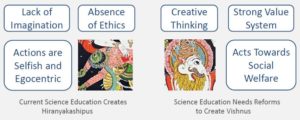
Science education when looked at in isolated manner is not going to be of much use for the students or the society. It has to be seen as a cog in the wheel of development of students and the society. Then only it can really fulfil its potential. And for that to happen we must make science learning experiential and relate it to our daily lives. At the same time we need to develop other perceptual faculties like sight and sound in students for a holistic cognitive development. This needs a major change in our curriculum to make arts an equally important subject in schools. But the approach to the arts has to be appropriate and must be aimed at improving the understanding of the world, nature and human conditions. This demands nothing less than excellence from the art faculty in schools. And last but not the least schools and curriculum must focus on inculcating appropriate value systems in students. This is the only way we can create Vishnus who by using their knowledge of science, intuition and creativity can transform to Narasimhas and solve the real problems around us and create better societies around them.
References
[1] Simin Soleimanifar, Zahra Jafari, Masoud Motasaddi Zarandy, Houman Asadi and Hamid Haghani (2016), Relationship between Intelligence Quotient and Musical Ability in Children with Cochlear Implantation. Iranian Journal of Otorhinolaryngol 28(88): 345–352
[2] Garreth Dottin (2016), Einstein’s Violin: The Hidden Connections between Scientific Breakthroughs and Art.
[3] Devi Prasad (1998), Art- The basis of education, ISBN: 8-123-72314-8
[4] Robert Greene (2012), Mastery, ISBN: 1-781-25091-X
[5] Harold Speed (2017), Oil Painting Technique and Materials. Dover Publication. ISBN: 0-486-25506-9
[6] United Nations Conference on Trade and Development (2013), Wake Up Before Its Too Late, UNCTAD Trade and Environment Review
Few Pics from the Conference
